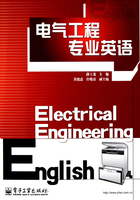
Lesson Six A.C.Switchboard
While D.C. switchboards may employ open type panels, metal clad dead-front equipment is widely used on A.C. systems. A.C. systems require additional apparatus to be switchboard-mounted;this includes frequency meters, synchroscopes, wattmeters, voltage and current transformers, ammeter switches, voltage regulators and means for adjusting the speed of the prime mover.
On an A.C. system the duty of fault interruption is made easier than on D.C. when an A.C. fault occurs the fault current, after the first few cycles, will pass through a current zero. Conversely a D.C. breaker can only interrupt the fault current by continually increasing the resistance of the arc until the latter can no longer maintain itself. Consequently, for a given type of circuit breaker, it is usually possible to obtain a higher interrupting capacity on A.C. than on D.C.
While there are several different types of A.C. switch-gear only air-breaker and molded case circuit breakers are in common use on marine systems. The voltages usually adopted for auxiliary power are either 380V or 440V with perhaps 3.3kV being used on larger vessels. When a circuit breaker is selected for a particular application, the principal factors which must be considered are system voltage, rated load current and the fault level at the point of installation.
For small installations, particularly those which do not include paralleling of the generators, simple metal clad switch-gear will suffice and may consist of standard self-contained switches or switch fuses assembled together to form a combined unit. With these units it is usual to interlock the switches with the lid or door so that the door cannot be opened while the switch is in the closed position and conversely the switch cannot be closed when the door is open. However, in most installations draw-out type switch-gear is now normally used and this greatly simplifies routine maintenance.
When a ship’s generator is subjected to an overload either a supporting generator must be paralleled or non-essential load dropped. If the overload is allowed to trip a generator circuit breaker, an even greater overload will be thrown onto any paralleled machines and cascade tripping will occur resulting in a complete loss of supply.
If the overload builds up so quickly that an additional machine cannot be connected then a generator over-current trip can be prevented by using a preference trip relay. This operates after a fixed time delay causing non-essential loads to be shed.
Each generator circuit breaker must be fitted with an over-current relay. On low voltage systems this is usually an integral part of the circuit breaker in the form of direct acting trip. An inverse time/current characteristic is normally employed. In order to provide rapid tripping of a generator with an internal fault a high set instantaneous relay is sometimes employed. Naturally it must only operate for currents in excess of the maximum generator fault current otherwise system discrimination would be lost.
As reverse current protection can’t be applied in the case of A.C. It is necessary to utilize reverse protection to prevent the generator acting an a motor in the event of loss of power by the prime mover. On diesel driven sets it is unlikely that damage would occur but it is still important to trip the circuit breaker in order to reduce the load imposed on remaining sets. To prevent improper operation of reverse power relays due to power surges, particularly when synchronizing, a time delay should be incorporated. Under-voltage protection on low voltage system is also accomplished by an integral under-voltage release on the circuit breaker.
New Words and Expressions
apparatus [ˌæpəˈreitəs] n. 仪器,设备,装置
mount[maunt] vt. 安装,固定,装配
frequency[ˈfriːkwənsɪ] n. 频率
arc[ɑːk] n. 弧,电弧
contact[ˈkɔntækt] n. 触头
extinguish[iksˈtiŋgwi∫] vt. 熄灭,取消,废除
mould[məuld] vt. 用模子做,浇铸
principal[ˈprinsəp(ə)l,-sip-] adj. 主要的
suffice[səˈfais] vt. 足够
self-contained[ˈselfkənˈteind] adj. 独立的,自给的
simplify[ˈsimplifai] vt. 简化,精简
cascade[kæsˈkeid] n. 级,级联,串联
preference[ˈprefərəns] n. 优先权,选择
integral[ˈintigrəl] adj. 组成的,完整的
excess[ikˈses,ˈekses] n. 超过
discrimination[disˌkrimiˈnei∫ən] n. 辨别力,鉴别
impose[imˈpəuz] vt. 把……强加
utilize [juːˈtɪlaɪz] vt. 利用
improper [imˈprɔpə] adj. 不适当的,不合理的
surge[səːdʒ] n. 电流冲击,浪涌电压
incorporate[inˈkɔːpəreit] vt. 结合,合并,使混合
accomplish [əˈkɔmpli∫] vt. 完成
Notes
(1)…apparatus to be switchboard-mounted…
“to be switchboard-mounted”这是一个不定式短语,修饰apparatus作定语。不定式短语作定语往往带有将来的含义。
例如:
The problem to be solved by the computer is rather complicated.
要由电子计算机解决的那个问题相当复杂。
除此之外,不定式短语还可作主语、宾语、状语和补语。
例如:
How to connect the resistors and capacitors properly is shown in the specifications.(作主语)
如何恰当地连接电阻和电容,已在说明书中说明。
There machines need to be oiled once a week.(作宾语)
这些机器需要每周加一次润滑油。
The problem is where to get the necessary spare parts.(作表语)
问题在于从哪里得到所需要的备件。
He came here to repair the motor with us.(作状语)
他来这里是和我们一起修理电动机的。
Gasoline is known to be made from crude oil.(主语补语)
人们知道,汽油是从原油中提炼出来的。
(2)non-essential译为“非本质的”,“次要的”。
在英语中,加前缀或后缀都是一种构词法,叫派生词。加上前缀后的派生词,一般不改变词性,而只改变其词义。
例如:
able unable
like dislike
possible impossible
regular irregular